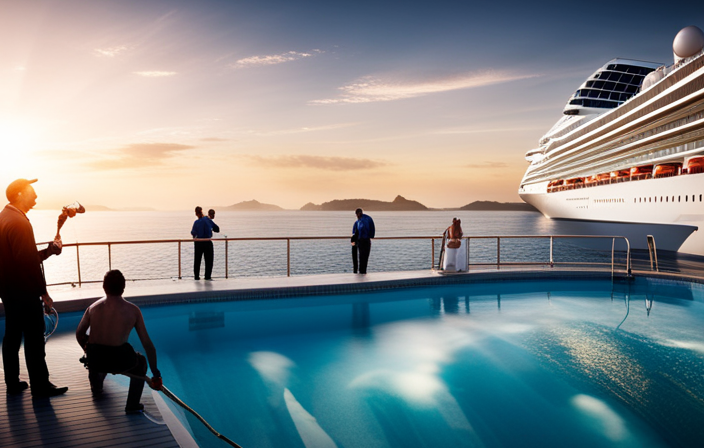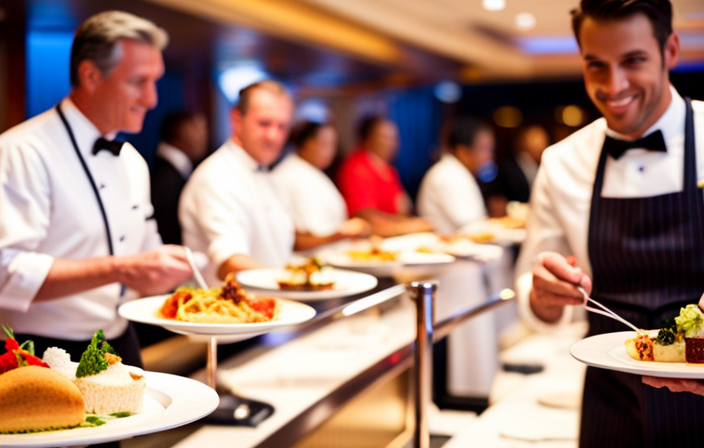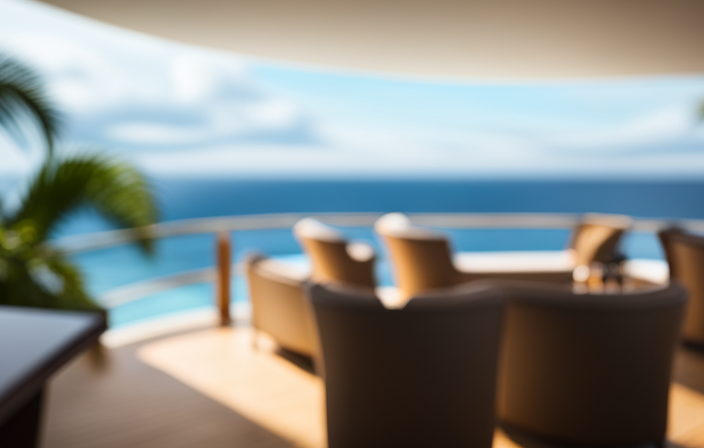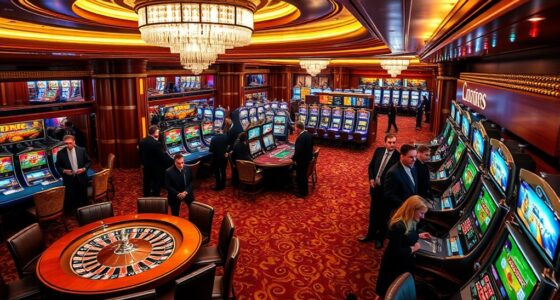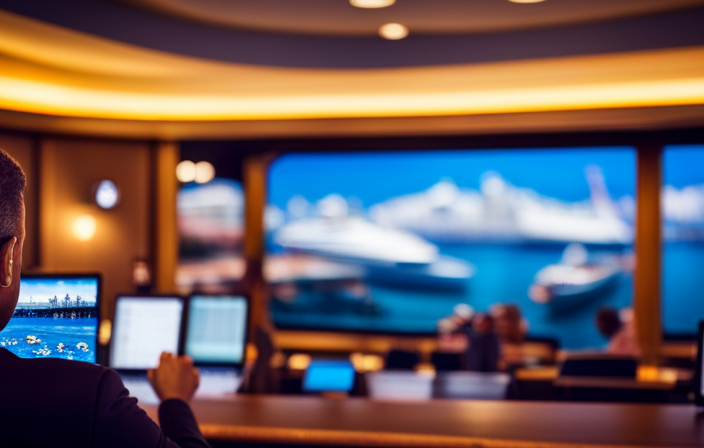Picture a cruise ship like a floating paradise where guests can get away from the summer heat and take a dip in cool pools. However, have you ever thought about how they fill these pools, given that the ship is in the middle of the vast saltwater ocean?
Well, let me dive into the fascinating world of how cruise ships fill their pools. It’s a complex process that involves water sourcing, treatment, desalination, filtration systems, chlorination, pumping, circulation, maintenance, water conservation, and safety measures. Just like a well-choreographed dance, each step is meticulously executed to ensure the pools are pristine, safe, and enjoyable for all passengers.
So, let’s take a deep dive into this aquatic wonderland and explore the secrets behind how cruise ships transform seawater into sparkling pools that beckon us to jump right in.
Key Takeaways
- Cruise ships prioritize water sourcing and conservation, using desalination systems to convert seawater into freshwater and advanced treatment systems to purify and recycle pool water.
- Pool water filtration and treatment methods include physical filtration, chemical disinfection, UV sterilization, and desalination techniques to ensure cleanliness and safety.
- Regular pool maintenance, including testing, circulation, cleaning, and chemical treatment, is carried out to maintain optimal pool conditions.
- Cruise ships comply with safety regulations, implement safety measures, and educate passengers on pool safety and hygiene practices to ensure passenger protection.
Water Sourcing: Obtaining the necessary water for filling the pools
Cruise ships gotta find where to get the water for fillin’ their pools. With water scarcity and ecological impact in mind, cruise lines have to carefully consider their water sourcing options.
Many ships have onboard desalination systems, which convert seawater into freshwater. This allows them to have a sustainable and reliable source of water. However, desalination can be an energy-intensive process and can have negative environmental consequences, such as the discharge of brine back into the ocean.
Some cruise lines have also started using advanced water treatment systems that purify and recycle the pool water, reducing the need for fresh water altogether. These systems ensure that the water is safe and clean for passengers to enjoy a refreshing dip.
Transitioning into the next section, let’s dive into how cruise ships treat their pool water to ensure its quality.
Water Treatment: Treating the water to ensure it is safe and clean for passengers
Passengers aboard cruise ships can enjoy a refreshing dip in pools that are treated meticulously, with an estimated 20,000 gallons of water filtered and sanitized every day. Water treatment regulations are strictly followed to ensure the safety and hygiene of the pool water.
The process begins with the removal of debris and particles through a combination of physical filtration methods such as sand filters and cartridge filters. This is followed by chemical disinfection methods, where chlorine or other sanitizing agents are added to eliminate harmful bacteria and viruses. The water is constantly monitored to maintain optimal disinfection levels and pH balance. Additionally, advanced technologies like UV sterilization may be employed to provide an extra layer of protection.
This comprehensive water treatment process guarantees that passengers can enjoy clean and safe swimming environments throughout their cruise experience.
Moving on to desalination, the next section explores the removal of salt from seawater to make it suitable for pool use.
Desalination: Removing salt from seawater to make it suitable for pool use
Desalination is the remarkable process of extracting salt from seawater, making it perfectly suitable for refreshing pool use. Cruise ships employ various desalination techniques to ensure their pools are filled with clean, safe water.
One common method is reverse osmosis, where seawater is forced through a semipermeable membrane to separate the salt molecules from the water molecules. Another technique is thermal evaporation, where the seawater is heated, causing the water to evaporate and leaving behind the salt.
These desalination processes are crucial for pool water purification, as saltwater can be corrosive and harmful to passengers. Once the salt is removed, the water can be treated further to maintain its cleanliness.
This sets the stage for the subsequent section on filtration systems, which use various methods to remove impurities from the water, ensuring a pristine swimming experience for passengers.
Filtration Systems: Using filtration systems to remove impurities from the water
Filtration systems on board use various methods to remove impurities from the water, ensuring a pristine swimming experience for guests. One interesting statistic is that these systems can remove up to 99% of bacteria and particles, making the water incredibly clean and safe to swim in.
-
High-pressure sand filters trap debris and larger particles, preventing them from entering the pool.
-
Cartridge filters capture smaller particles, ensuring even finer filtration.
-
UV disinfection systems use ultraviolet light to kill bacteria and viruses, further enhancing water purity.
-
Ozone systems generate ozone gas, which oxidizes and destroys impurities in the water.
-
Membrane filtration systems employ a series of membranes with tiny pores to filter out contaminants.
These water purification techniques combine to provide a swim-ready pool environment.
However, before taking a dip, another crucial step involves chlorination: adding chlorine to the water to kill bacteria and maintain cleanliness.
Chlorination: Adding chlorine to the water to kill bacteria and maintain cleanliness
One key step in ensuring a pristine swimming experience on board is the addition of chlorine to the water, effectively killing bacteria and maintaining cleanliness. Chlorine is a widely used disinfectant in swimming pools due to its ability to destroy harmful microorganisms. However, there are alternatives to chlorine that some cruise ships may explore, such as ozone or UV light treatment. These alternatives can provide similar disinfection effects without the potential health effects associated with chlorination. Chlorine, when used in the correct amounts, is generally safe for swimmers. However, prolonged exposure to high levels of chlorine can cause skin and eye irritation. To prevent this, cruise ships carefully monitor chlorine levels and maintain them within the recommended range. Moving on to the next step, adjusting the pH levels of the water ensures it is comfortable for swimmers.
pH Balance: Adjusting the pH levels of the water to ensure it is comfortable for swimmers
Maintaining the pH balance of the water ensures that you can enjoy a comfortable swim without any discomfort or irritation. To achieve this, cruise ships use a combination of techniques to adjust the temperature and monitor chemical levels in the pool water.
Here is a step-by-step breakdown of how they do it:
-
Adjusting temperature: Cruise ships have sophisticated temperature control systems that allow them to maintain the ideal water temperature for swimming. This ensures that the water is neither too cold nor too hot, providing a pleasant swimming experience for passengers.
-
Monitoring chemical levels: Regular testing is done to ensure that the pool water has the right chemical balance. This includes measuring the chlorine and pH levels to ensure they are within the recommended range. Adjustments are made as necessary to keep the water safe and comfortable for swimmers.
By properly adjusting the temperature and monitoring chemical levels, cruise ships create an environment where passengers can enjoy a refreshing swim.
This leads us to the next section about pumping and circulation: utilizing pumps and circulation systems to keep the water moving and prevent stagnation.
Pumping and Circulation: Utilizing pumps and circulation systems to keep the water moving and prevent stagnation
After adjusting the pH levels of the water to ensure its comfortability, the next step in maintaining the cruise ship pools is pump maintenance and water circulation. These two aspects play a crucial role in keeping the water clean, fresh, and safe for swimmers.
The pumps are responsible for continuously circulating the water, preventing it from becoming stagnant and creating the perfect environment for bacteria to thrive. Regular pump maintenance is essential to ensure proper functioning and prevent any breakdowns that could disrupt the pool’s operation.
Additionally, the circulation system helps distribute chemicals evenly throughout the water, further enhancing its cleanliness and safety. By maintaining a consistent flow, the water remains crystal clear and inviting.
Transitioning into the subsequent section about pool maintenance, it is important to emphasize the significance of regular cleaning and maintenance to keep the pools in optimal condition.
Pool Maintenance: Regular cleaning and maintenance to keep the pools in optimal condition
To keep your pool in optimal condition, it’s crucial to regularly clean and maintain it. Here are four key steps you can take to ensure your pool stays clean and ready for use:
-
Skimming and Vacuuming: Regularly skim the surface of the pool to remove debris, such as leaves and bugs. Additionally, vacuum the pool floor and walls to eliminate dirt and algae buildup.
-
Cleaning the Filters: The pool’s filters play a vital role in keeping the water clear. Clean or replace them regularly to maintain proper filtration and prevent clogging.
-
Testing and Balancing Chemicals: Regularly test the water’s pH levels and adjust as necessary to maintain a safe and comfortable environment. This includes adding chemicals like chlorine to kill bacteria and prevent algae growth.
-
Brushing and Scrubbing: Use a pool brush to scrub the pool walls and floor, removing any accumulated algae or dirt.
Regular maintenance and pool cleaning are essential to ensure your pool remains in top shape. By implementing these measures, you can enjoy a clean and inviting swimming experience.
As we move into the next section about water conservation, it’s important to consider ways to conserve water and reduce waste.
Water Conservation: Implementing measures to conserve water and reduce waste
Let’s talk about ways we can save water and reduce waste in our pools! In today’s world, water scarcity is a growing concern, and it’s our responsibility to implement water-saving techniques.
One effective method is to install pool covers when the pool isn’t in use. This helps to reduce evaporation and keeps the pool water clean for a longer period.
Additionally, we can use efficient filtration systems that recycle and treat the pool water, minimizing the need for fresh water.
Regular monitoring and maintenance of the pool equipment also ensure that there aren’t any leaks or wastage.
By implementing these measures, we not only conserve water but also contribute to a sustainable environment.
Now, let’s discuss safety measures to ensure that the pools meet safety standards and regulations for passenger enjoyment.
Safety Measures: Ensuring that the pools meet safety standards and regulations for passenger enjoyment
Ensuring that the pools meet safety standards and regulations for passenger enjoyment is of paramount importance when it comes to maintaining a safe and enjoyable swimming experience. Cruise ships take several safety precautions to ensure the well-being of their passengers. Here are five key measures they implement:
-
Lifeguard Training: Cruise ship staff undergo thorough lifeguard training to handle any emergency situation that may arise in the pool area.
-
Pool Depth and Design: The pools are designed with different depths to cater to swimmers of all abilities, ensuring everyone can enjoy the water safely.
-
Continuous Supervision: Trained lifeguards are always present around the pool area, keeping a watchful eye on swimmers and ready to respond to any potential hazards.
-
Safety Equipment: Cruise ships provide a range of safety equipment, including life jackets and flotation devices, to enhance passenger safety.
-
Regular Maintenance: The pools undergo regular maintenance and cleaning to ensure water quality and prevent any potential health risks.
By implementing these measures, cruise ships strive to create a safe and enjoyable swimming environment for their passengers.
Frequently Asked Questions
How often are the pools on cruise ships cleaned and maintained?
The pools on cruise ships are regularly maintained and cleaned to ensure a safe and enjoyable experience for passengers. Pool maintenance includes regular cleaning, water testing, and filtration system maintenance to maintain hygiene standards and water quality.
What safety measures are in place to ensure the pools meet regulations and standards?
To meet regulations and standards, cruise ships implement rigorous safety measures for pool water filtration and chlorination. This ensures clean and bacteria-free pool water, minimizing health risks and providing a safe swimming environment for passengers.
How is the pH level of the pool water adjusted?
Adjusting the pH level of the pool water is crucial for pool maintenance and sanitation. It involves carefully adding chemicals to achieve the optimal balance. It’s like performing a delicate symphony, ensuring the water is safe and inviting for all swimmers.
Are there any measures in place to conserve water on cruise ships?
Water conservation practices on cruise ships are crucial due to their environmental impact. Measures include using water-saving technologies, such as low-flow faucets and showers, and recycling and treating water for reuse.
How long does the water treatment process take before the pools are ready for use?
The water treatment process for cruise ship pools typically takes several hours to complete. This includes filtration, disinfection, and chemical balancing to ensure the water is safe and clean for passengers. Pool maintenance frequency varies depending on the ship’s regulations and usage.
Conclusion
In conclusion, the process of filling cruise ship pools involves various steps to ensure the safety and enjoyment of passengers.
From sourcing and treating water to desalination and filtration, each step is crucial in maintaining clean and safe pool water.
With the addition of chlorine, regular maintenance, and water conservation measures, cruise ships are able to provide optimal pool conditions.
By adhering to safety standards and regulations, cruise ships create an environment where passengers can relax and enjoy their time at sea.

